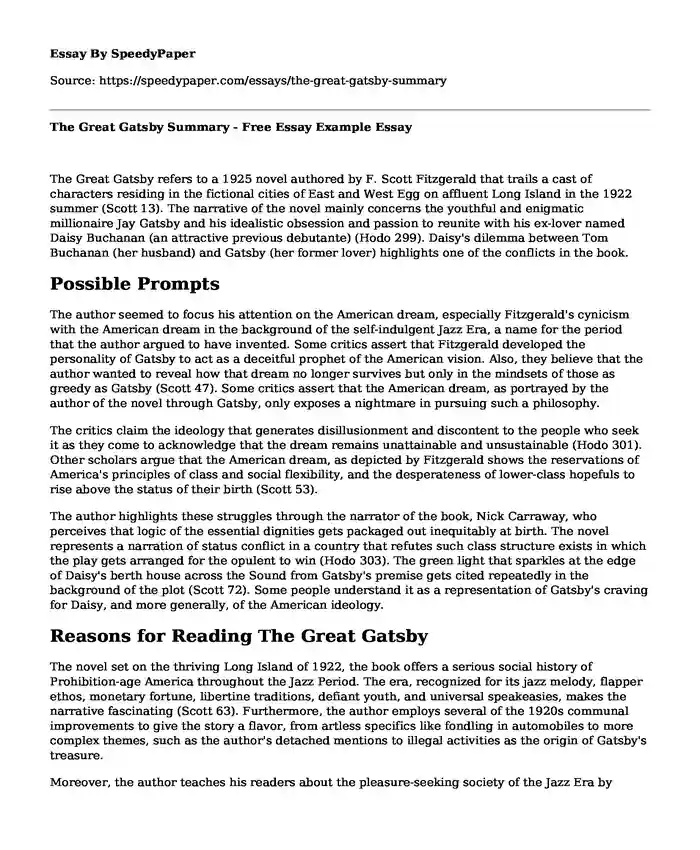
| Essay type: | Book review |
| Categories: | The Great Gatsby Character analysis F. Scott Fitzgerald |
| Pages: | 3 |
| Wordcount: | 701 words |
The Great Gatsby refers to a 1925 novel authored by F. Scott Fitzgerald that trails a cast of characters residing in the fictional cities of East and West Egg on affluent Long Island in the 1922 summer (Scott 13). The narrative of the novel mainly concerns the youthful and enigmatic millionaire Jay Gatsby and his idealistic obsession and passion to reunite with his ex-lover named Daisy Buchanan (an attractive previous debutante) (Hodo 299). Daisy's dilemma between Tom Buchanan (her husband) and Gatsby (her former lover) highlights one of the conflicts in the book.
Possible Prompts
The author seemed to focus his attention on the American dream, especially Fitzgerald's cynicism with the American dream in the background of the self-indulgent Jazz Era, a name for the period that the author argued to have invented. Some critics assert that Fitzgerald developed the personality of Gatsby to act as a deceitful prophet of the American vision. Also, they believe that the author wanted to reveal how that dream no longer survives but only in the mindsets of those as greedy as Gatsby (Scott 47). Some critics assert that the American dream, as portrayed by the author of the novel through Gatsby, only exposes a nightmare in pursuing such a philosophy.
The critics claim the ideology that generates disillusionment and discontent to the people who seek it as they come to acknowledge that the dream remains unattainable and unsustainable (Hodo 301). Other scholars argue that the American dream, as depicted by Fitzgerald shows the reservations of America's principles of class and social flexibility, and the desperateness of lower-class hopefuls to rise above the status of their birth (Scott 53).
The author highlights these struggles through the narrator of the book, Nick Carraway, who perceives that logic of the essential dignities gets packaged out inequitably at birth. The novel represents a narration of status conflict in a country that refutes such class structure exists in which the play gets arranged for the opulent to win (Hodo 303). The green light that sparkles at the edge of Daisy's berth house across the Sound from Gatsby's premise gets cited repeatedly in the background of the plot (Scott 72). Some people understand it as a representation of Gatsby's craving for Daisy, and more generally, of the American ideology.
Reasons for Reading The Great Gatsby
The novel set on the thriving Long Island of 1922, the book offers a serious social history of Prohibition-age America throughout the Jazz Period. The era, recognized for its jazz melody, flapper ethos, monetary fortune, libertine traditions, defiant youth, and universal speakeasies, makes the narrative fascinating (Scott 63). Furthermore, the author employs several of the 1920s communal improvements to give the story a flavor, from artless specifics like fondling in automobiles to more complex themes, such as the author's detached mentions to illegal activities as the origin of Gatsby's treasure.
Moreover, the author teaches his readers about the pleasure-seeking society of the Jazz Era by creating a relevant storyline within the ancient context of the highly wild, extravagant period in American history (Scott 92). Therefore, the Great Gatsby reflects Fitzgerald's desire to articulate his indecisive outlooks concerning the Jazz Era, a period whose themes he later considered as representing his lifespan. The Great Gatsby expresses various themes, such as idealism, decadence, resistance to change, excess, and social upheaval building an image of the twentieth century that reflects the cautionary narrative of the American dream (Hodo 304).
Conclusion
The novel represents the author's youth events in which the author was influenced by the 1920s period which signified an ethically permissive era when Americans of different ages became dissatisfied with predominant social models. The American people got monomaniacal and preoccupied with hedonism. The author tried to express his opinion on the Jazz Period concerning the period and incidences in his life. Class systems also influenced the author's storyline in which rich girls got married to their counterparts from the same status.
Works Cited
Hodo, Zamira. "The Failure of the American Dream in “The Great Gatsby”-Fitzgerald." European Journal of Multidisciplinary Studies 2.7 (2017): 299-305. www.journals.euser.org/index.php/ejms/article/view/2819. Accessed 29th of August, 2020.
Scott, Fitzgerald F. The Great Gatsby. Ripol Klassik (2017): p. 1-128 www.books.google.com/books. Accessed 29th of August, 2020.
Cite this page
The Great Gatsby Summary - Free Essay Example. (2023, Nov 24). Retrieved from https://speedypaper.net/essays/the-great-gatsby-summary
Request Removal
If you are the original author of this essay and no longer wish to have it published on the SpeedyPaper website, please click below to request its removal:
- The Great Gatsby Essay
- Those Winter Sundays: Gender and Sexuality, Free Essay on the Poem
- Franz Liszt - Biography Essay Sample
- Haydn, Mozart and Beethoven in Our Free Example
- Essay Example on Lord of the Flies and the Most Dangerous Game
- Biography of Dame Iris Murdoch: British Novelist and Philosopher
- Henry VII and the Breton Wars - Free Essay Sample
Popular categories




